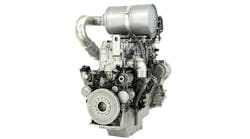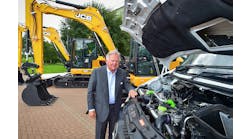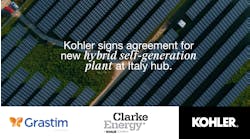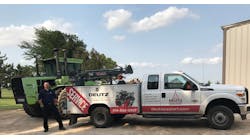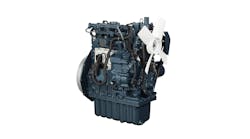| Participants: Doug Laudick, manager of product planning, John Deere Power Systems Dave Hahn, Volvo CE, manager hauler/loader/power train customer solutions team Chris Giorgianni, vice president, product, JCB |
RER: What is the status of your product line in relation to Tier 4i and Tier 4f?
Doug Laudick: John Deere has more than 20,000 Tier 4i off-highway diesel engines in the field with more than 8 million customer hours in operation. We have not only listened to and analyzed customer feedback regarding Tier 4i engine performance, but we also have monitored thousands of these engines using our JDLink telematics system. As we fully expected after rigorous lab and field testing, John Deere Tier 4i engines meet stringent emissions regulations while delivering performance, operating efficiency and reliability.
In March 2012, John Deere announced continuation of our planned “building-block” approach to meet the even more challenging Tier 4f regulations. To achieve compliance, we developed the Integrated Emissions Control (IEC) system, which encompasses any combination of after-treatment and emissions-reduction components integrated in that building-block approach.
For engines 75 hp and above, the IEC system will consist of a diesel oxidation catalyst (DOC), a diesel particulate filter (DPF) and a selective catalytic reduction (SCR) system specifically designed to meet the demands of off-highway applications. The DOC/DPF exhaust filter reduces particulate matter while cooled exhaust gas recirculation (DGR) and the optimized SCR system reduce nitrogen oxides (NOx) to the regulatory levels of Tier 4f. John Deere Tier 4f engines below 75 hp will meet regulations using an IEC system consisting of an exhaust filter without cooled EGR or SCR.
Regardless of power range, the IEC system will provide a Tier 4f solution that optimizes engine performance, operating efficiency and reliability for our customers.
Dave Hahn: The Volvo product line from 25 hp through 75 hp met the Tier 4i requirements in 2008. Engines with hp range 75 to 750 met Tier4i at the beginning of 2011.
Chris Giorgianni: We have rolled out our Tier 4i product on machines with greater than 174 hp already and are in the process of rolling out with product between 75 and 174 hp. For Tier 4f, engineering work is ongoing.
RER: What types of adjustments did your company make to be compliant with T4i and what types of changes will you make to be compliant with T4f?
Laudick: To meet increasingly stringent emissions regulations, we have followed a building-block approach in which we have systematically adopted emissions-reduction technologies to meet each regulatory tier. Throughout the transitions between tiers, we have focused on incorporating technologies that achieve applicable regulations while maintaining or improving performance and total fluid economy. We also have maintained a firm commitment to solutions that minimize operator impact.
For Tier 4i, we started with our proven PowerTech Plus Tier 3 engine platform — featuring “enhanced” cooled EGR for NOx control — and added a DOC/DPF exhaust filter for reducing PM. Moving into Tier 4f configurations for engines 75 hp and above, our IEC system will include an exhaust filter along with an SCR system that in conjunction with cooled EGR technology achieves the more stringent NOx levels.
Until facing the NOx emissions levels required by Tier 4f, John Deere achieved the mandated NOx levels with our cooled EGR technology. We consider SCR an appropriate technology building block for Tier 4f, now that it is more mature for off-highway applications, the diesel exhaust fluid (DEF) supply chain infrastructure is better developed, and John Deere has optimized the performance of our SCR system. The combination of cooled EGR technology and the optimized IEC system will enable our engines to meet emissions regulations while using less DEF. DEF consumption with our Tier 4f engines will be 1 to 3 percent of diesel fuel consumption depending on the application.
Our Tier 4f engines below 75 hp will meet regulations using an IEC system consisting of an exhaust filter without cooled EGR or SCR.
While Tier 4f standards maintain the PM levels established by Tier 4i regulations, increased pressures created by John Deere Tier 4f high-pressure fuel systems will reduce engine-out PM and extend intervals between active exhaust filter regeneration, improving fuel economy from Tier 4i.
Hahn: Volvo CE has a unique advantage. Our power train division developed engines to meet the highway truck/bus EPA 07 emissions, this technology was carried over to construction equipment Tier 4i emissions regulations as will the EPA emissions on highway truck/bus 2010 be carried over to meet Tier 4F.
Giorgianni: Specifically with the JCB Ecomax engine, which powers many of our products, JCB is able to achieve Tier 4i without the need for after-treatment. Specific technology applied with the engine includes:
- High Pressure Fuel System (Common Rail) — Results in better atomization and mixing of fuel, which reduces NOx, PM & HC
- Variable Geometry Turbo — A VGT allows more precise control of the amount of air that enters the engine, making combustion as efficient as possible and delivering three key benefits: improved durability, improved fuel economy and reduced exhaust emissions
- Exhaust Gas Recirculation — EGR is a technique that recirculates a portion of exhaust gases back into the combustion chamber, lowering temperature and oxygen levels in the combustion chamber and reducing NOx emissions
RER: Apart from the obvious fact that use of T4i and T4f engines will be required because of EPA regulations, what are the benefits of using these engines?
Laudick: Despite the significant challenge posed by Tier 4i emissions standards, John Deere Tier 4i engines have maintained — and in many cases improved — engine performance. Rated engine power levels have grown, transient response has improved, torque rise has increased and low-speed torque has been maintained.
Our building-block approach of utilizing cooled EGR, exhaust filter and SCR technologies will ensure that Tier 4 Final engine performance meets or exceeds that of our Tier 4i engines. John Deere Tier 4f engines will provide the same or higher levels of power density and torque along with a level of transient response that meets or exceeds that offered with our Tier 4i engines.
Our Tier 4i engines with cooled EGR and exhaust filters operating on diesel fuel only have been tested in many applications globally. Low DEF dosing rates and a higher-pressure fuel delivery system will enable John Deere Tier 4f engines to meet or improve upon the total fluid economy of our Tier 4i engine models.
The John Deere Tier 4f SCR solution is different from alternative Tier 4i SCR solutions, because the combination of cooled EGR technology and the IEC system will enable our engines to meet emissions requirements while utilizing less DEF — 1 to 3 percent of diesel fuel consumption depending on the application. Lower DEF consumption means DEF tanks can be smaller, impact on equipment applications is minimized, DEF filter service intervals can be extended, vehicles can achieve a longer interval between DEF tank refills, and operator involvement is reduced. Our enhanced electronic control unit will monitor and control the Tier 4f engine and IEC system components, providing superior fluid efficiency without compromising engine performance or machine productivity.
Hahn: The technology to produce T4i and T4f engines brought with it a great increase in fuel efficiency and performance. Volvo has made the financial and technological commitment to increase long-term machine efficiency while at the same time reducing environmental impact for a sustainable fuel-efficient future.
Giorgianni: Specifically with the JCB Ecomax engine, because we do not need after-treatment, we see significantly lower servicing costs. From a performance standpoint, we have increased productivity, with the higher torque supplied by the engine at low revs. Further, we are seeing up to 10-percent fuel savings versus Tier 3 equivalent models. Also, because the engines can be reprogrammed when being sold into non-regulated territories, we anticipate higher residual values as well.
RER: Rental companies are obviously concerned because of the increased costs of using Tier 4 engines. What is your response to that concern?
Laudick: Purchase price of Tier 4 engines will continue to be a sensitive issue. John Deere remains committed to providing the best overall value through improved engine performance, which results in increased machine productivity, the best total fluid economy, improved reliability and the lowest operating costs.
Hahn: Equipment manufacturers are not the only ones concerned about a clean environment, the end user understands the need to have machines that protect the environment and the relative costs that come with this new technology. The initial increased purchase price of a Tier 4 product is minor when combined with the overall owning/operating costs that decrease because of the increased fuel efficiency.
Giorgianni: The JCB Ecomax engine’s intelligent design gives our customers a tier 4i compliant engine without the need for after-treatment. No Diesel Particulate Filter to service, no ad blue tank to fill, and no increase in running costs or lost productivity on the jobsite.
With the onset of Tier 4i, we also recognized that there was a general concern that residual values will be negatively impacted. This is due to the fact that T4i complaint engines can be more easily damaged with the lower quality diesel fuel typically used in non-regulated territories throughout the world. JCB has addressed this point as well, and this will not be an issue with JCB machines powered by the JCB Ecomax engine.
When the machine is ready for re-sale into a non-regulated country, JCB will offer a low-cost kit to reprogram the engine back, enabling the machine to operate effectively where poorer quality fuels are used. We will do this through a recalibration of the engine ECU and the addition of a “non-compliant” label on the machine.
RER: There is interest in the marketplace in alternative forms of fuel. Are you working on or doing research into engines with hybrid engines or alternative fuels?
Laudick: There is increased interest in — and use of — biofuels. John Deere engines operate efficiently on certain biodiesel blends, providing optimal performance and fuel-choice flexibility. While a 5-percent biodiesel blend (B5) is preferred, a concentration of up to 20-percent (B20) may be used. Regardless of biodiesel blend level, the fuel should meet ASTM D6751 (U.S.) standards or an equivalent specification.
Hahn: Our Highway truck and bus divisions are working on a number of alternative forms of fuel, such as, DME, biodiesel, synthetic diesel, methanol, ethanol, biogas, biogas & biodiesel and hydrogen biogas.
Giorgianni: The engines can work utilizing B20 already. Further, we have a lot of exciting projects that we are working on for the future.
